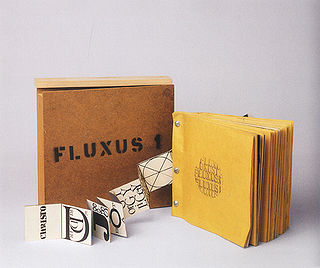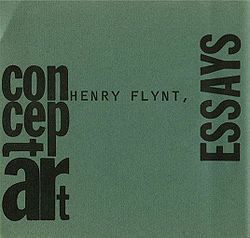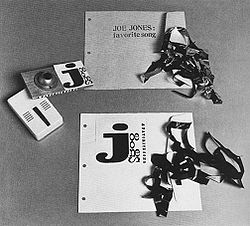
Fluxus 1
Encyclopedia

Lithuanian-American
Lithuanian Americans are citizens of the United States who are of Lithuanian ancestry. According to the United States Census, there are 712,165 Americans of full or partial Lithuanian descent....
artist George Maciunas
George Maciunas
George Maciunas was a Lithuanian-born American artist. He was a founding member of Fluxus, an international community of artists, architects, composers, and designers...
, containing works by a series of artists associated with Fluxus
Fluxus
Fluxus—a name taken from a Latin word meaning "to flow"—is an international network of artists, composers and designers noted for blending different artistic media and disciplines in the 1960s. They have been active in Neo-Dada noise music and visual art as well as literature, urban planning,...
, the international collective of avant-garde artists primarily active in the 1960s and 1970s. Originally published in New York, 1964, the contents vary from edition to edition, but usually contain work by Ay-O
Ay-O
is a Japanese artist, who has been associated with Fluxus since its international beginnings in the 1960s.-From Democrato to Fluxus:Probably, the best reference to understand the early years of Ay-O is the autobiographical retrospective book in the references "Ay-O, Over the Rainbow, Ay-O...
, George Brecht
George Brecht
George Brecht , born George Ellis MacDiarmid, was an American conceptual artist and avant-garde composer as well as a professional chemist who worked as a consultant for companies including Pfizer, Johnson & Johnson, and Mobil Oil...
, Alison Knowles
Alison Knowles
Alison Knowles in New York City is an American visual artist known for her soundworks, installations, performances, and publications. Knowles was very active in the Fluxus movement, and continues to create work inspired by her Fluxus experience....
, György Ligeti
György Ligeti
György Sándor Ligeti was a composer of contemporary classical music. Born in a Hungarian Jewish family in Transylvania, Romania, he briefly lived in Hungary before becoming an Austrian citizen.-Early life:...
, Yoko Ono
Yoko Ono
is a Japanese artist, musician, author and peace activist, known for her work in avant-garde art, music and filmmaking as well as her marriage to John Lennon...
, Robert Watts
Robert Watts (artist)
Robert Watts was an American artist best known for his work as a member of the international Avant-garde art movement Fluxus. Born in Burlington, Iowa June 14, 1923, he became Professor of Art at Douglass College, Rutgers University, New Jersey in 1953, a post he kept until 1984...
and La Monte Young
La Monte Young
La Monte Thornton Young is an American avant-garde composer, musician, and artist.Young is generally recognized as the first minimalist composer. His works have been included among the most important and radical post-World War II avant-garde, experimental, and contemporary music. Young is...
amongst many others.
The work has become famous as an early example of conceptual art
Conceptual art
Conceptual art is art in which the concept or idea involved in the work take precedence over traditional aesthetic and material concerns. Many of the works, sometimes called installations, of the artist Sol LeWitt may be constructed by anyone simply by following a set of written instructions...
, and as one of the defining products of the Fluxus collective.
Early fluxus

The AG Gallery and proposals for a Yearbox
Maciunas had originally set up the AG Gallery, 925 Madison Avenue, New YorkNew York
New York is a state in the Northeastern region of the United States. It is the nation's third most populous state. New York is bordered by New Jersey and Pennsylvania to the south, and by Connecticut, Massachusetts and Vermont to the east...
, to exhibit abstract art and to sell ancient musical instruments; upon meeting La Monte Young
La Monte Young
La Monte Thornton Young is an American avant-garde composer, musician, and artist.Young is generally recognized as the first minimalist composer. His works have been included among the most important and radical post-World War II avant-garde, experimental, and contemporary music. Young is...
and Richard Maxfield
Richard Maxfield
Richard Maxfield was a composer of instrumental, electro-acoustic, and electronic music.Born in Seattle, he most likely taught the first University-level course in electronic music in America at the New School for Social Research...
in late 1960, however, he 'was suddenly confronted with the most radical ideas in art.' Overnight, the gallery was transformed into a greenhouse for 'the germination of Fluxus', hosting events by Dick Higgins
Dick Higgins
Dick Higgins was a composer, poet, printer, and early Fluxus artist. Higgins was born in Cambridge, England, but raised in the United States in various parts of New England, including Worcester, Massachusetts, Putney, Vermont, and Concord, New Hampshire.Like other Fluxus artists, Higgins studied...
, Jackson Mac Low
Jackson Mac Low
Jackson Mac Low was an American poet, performance artist, composer and playwright, known to most readers of poetry as a practioneer of systematic chance operations and other non-intentional compositional methods in his work, which Mac Low first experienced in the musical work of John Cage, Earle...
, Yoko Ono
Yoko Ono
is a Japanese artist, musician, author and peace activist, known for her work in avant-garde art, music and filmmaking as well as her marriage to John Lennon...
, La Monte Young and others. All of these artists would be included in the forthcoming Fluxus 1; the first known mention of the name Fluxus came on the invitation cards to 3 events held at the gallery, Spring 1961, in which guests were asked to contribute $3 to 'help publish Fluxus magazine'.
The gallery had gone bankrupt by mid 1961; to avoid his creditors, Maciunas took a job working for the US Army as a freelance designer in Wiesbaden
Wiesbaden
Wiesbaden is a city in southwest Germany and the capital of the federal state of Hesse. It has about 275,400 inhabitants, plus approximately 10,000 United States citizens...
, West Germany. He took many of the scores collected by La Monte Young for AN ANTHOLOGY, and whilst working on the design and printing for that, also began work on his own anthology Fluxus 1. Modelled in many ways on An Anthology, both works would prove difficult to publish. AN ANTHOLOGY appeared in Spring 1963; Most of Fluxus 1 was printed by the same German printers contemporaneously, but Maciunas doesn't seem to have put any copies together until sometime in early 1964, by which time he'd left his job in Germany due to bad health and had returned to New York. His letters leave a paper trail of torturous dealings with German printers;
"Fluxus 1 deadline is now closed, (all works are at the printer who is scratching his head to the bone.) It should be out in Jan...." George Maciunas, Dec 2 1962
"Fluxus 1 $2000 (now 400 pages thick) is 80% completed - very slow printer! but I think I will have them ready end of March..." George Maciunas, March 11, 1963
"...I will stay in Wiesbaden till Printer completes Fluxus 1.... (2 printers are working now.) They should have it completed by June 15...." George Maciunas, before June 8, 1963
"Please accept our belated acknowledgement of your order for Fluxus 1 yearbook. Due to financial difficulties, this fat book will not be issued but the contents will be included in the monthly Fluxus newspaper..." George Maciunas, Nov 19, 1963
"FLUXUS 1964 EDITIONS, AVAILABLE NOW... Fluxus 1 Anthology of yet unpublished works... Loose leaf binding (nonperiodically renewable), with objects in wood box $6" Fluxus Newspaper no3, March 1964
Originally intended as a six part series of yearboxes covering America (1), Northern Europe (2), Japan (3), 'Homage To The Past' (4), Southern Europe (5) and Eastern Europe (6), only Fluxus 1 was actually published; whilst predominantly anthologising American artists, both European and Japanese artists were included from material that had originally been intended for other volumes in the series. The book originally sold for $6, with a 'Luxus Fluxus' edition costing $12 containing 'film, tape, objects and accessories'
Fluxus, collectivism & Anti-art
Amongst many other influences, Maciunas was directly inspired by LEFLEF
LEF may refer to:* LEF, the Lymphoid enhancer-binding factor 1.* LEF , a journal of aesthetics published in the Soviet Union in the 1920s.* Library Exchange Format in Electronic design automation domain....
, the communist journal founded by Mayakovsky
Mayakovsky
Vladimir Mayakovsky was a Russian poet and playwright, among the foremost representatives of early-20th century Russian Futurism.Mayakovsky or Mayakovskaya may also refer to:...
and Ossip Brik; an artistic organisation aimed at unifying left-wing artists to help build the newly emerging communist state in Russia. Fluxus 1 was Maciunas' first attempt at creating a coherent collective voice, an attempt to erode the artist's status as heroic individual & his first attempt to 'communicate the concept of the self-sufficiency of the audience, an art where anything can substitute for an art work and anyone can produce it.'
In a lecture given on the June 9, 1962, Wuppertal
Wuppertal
Wuppertal is a city in North Rhine-Westphalia, Germany. It is located in and around the Wupper river valley, and is situated east of the city of Düsseldorf and south of the Ruhr area. With a population of approximately 350,000, it is the largest city in the Bergisches Land...
, West Germany, to coincide with the launch of the Brochure Prospectus for the Fluxus Yearboxes, Maciunas stated that;
"The anti-art forms are primarily directed against art as a profession, against the artificial separation of producer or performer, of generator and spectator or against the separation of art and life. They oppose forms artificial in themselves, models or methods of composition, of artificially constructed phenomena in the various areas of artistic practice, against intentional, conscious formalism and against the fixation of art on meaning, against the demand of music to be heard and that of plastic art to be seen; and finally against the thesis that both should be acknowledged and understood. Anti-art is life, nature; true reality is the one and all. The bird song is anti-art. The pouring rain, the chattering of an impatient audience, sneeze noises... or compositions like "letting a butterfly caught in a net fly away" or "what an audience left to its own devices does for amusement"- all of these examples may be viewed in this sense as anti-art."
Maciunas sent out requests for 'critical or non-critical, rational or irrational essays'; scores, instructions...visual compositions for reproductions, collages, photographs.... solid objects, scraps, smears, junk, garbage, rags, ready-makes (sic), found objects... or an object (like a flat painting) cut into 200 parts.' As the yearbox developed, Maciunas became increasingly interested in what he referred to as 'Concretism', derived from Duchamp's
Marcel Duchamp
Marcel Duchamp was a French artist whose work is most often associated with the Dadaist and Surrealist movements. Considered by some to be one of the most important artists of the 20th century, Duchamp's output influenced the development of post-World War I Western art...
ideas about the 'readymade'. In effect, concretism refers to works that don't attempt to transform themselves; objects such as George Brecht's Exit that remains resolutely a sign indicating the exit.
"The best Fluxus ‘Composition’ is a most non-personal, ‘readymade’ one like Brecht's ‘Exit’—it does not require any of us to perform it since it happens daily without any ‘special’ performance of it. Thus our festivals will eliminate themselves (and our need to participate) when they become total readymades (like Brecht's exit)" (see http://1.bp.blogspot.com/__FSXbtt4Jv4/RyDip8DbmhI/AAAAAAAAAGU/oseRlklVgic/s320/brecht_exit.jpg)
The book itself

Contents might include: a Finger Envelope by Ay-O featuring an envelope with a slit in it containing a nylon stocking; A Favorite Song by Joe Jones
Joe Jones (Fluxus artist)
-Formation:Joe Jones grew up in Greenpoint, Brooklyn and received a classical musical education at Hartnett Music School in New York City. In the late 1950s he began a short career as a jazz drummer. In 1960 Jones began to study avant-garde experimental composition first briefly with John Cage and...
containing 'a scramble of used music typewriter ribbons'; Disappearing Music for Envelopes by Mieko Shiomi consisting of a sequence of envelopes of diminishing sizes within each other; the music score for Trois Bagatelles by Györgi Ligeti; or An Opera (see http://www.artnotart.com/fluxus/ewilliams-anopera.html), a short story written on a long scroll by Emmett Williams
Emmett Williams
Emmett Williams was an American poet and visual artist.Williams was born in Greenville, South Carolina, and grew up in Virginia, and lived in Europe from 1949 to 1966...
.
Copies of Fluxus 1 were assembled over a period of 13 years, and whilst the form and much of the content remained fairly stable, 'Maciunas' attitude toward certain artists and/or works in the anthology changed, some works got lost or mislaid, and others ran out of stock.' Marginal figures in Fluxus, such as Giuseppe Chiari and Sohei Hashimoto, were dropped in favour of artists such as Yoko Ono and the Hi Red Center, whilst Dick Higgins
Dick Higgins
Dick Higgins was a composer, poet, printer, and early Fluxus artist. Higgins was born in Cambridge, England, but raised in the United States in various parts of New England, including Worcester, Massachusetts, Putney, Vermont, and Concord, New Hampshire.Like other Fluxus artists, Higgins studied...
is noticeable by his absence after a feud with Maciunas over the setting up of the Something Else Press
Something Else Press
Something Else Press was founded by Dick Higgins in 1963. It published many important Intermedia texts and artworks by Higgins, Ray Johnson, Gertrude Stein, George Brecht, Daniel Spoerri, Bern Porter, John Cage, Emmett Williams and others. The Something Else Press was an early publisher of...
.
There are thought to be more than a hundred boxes manufactured between 1964 and 1977.

